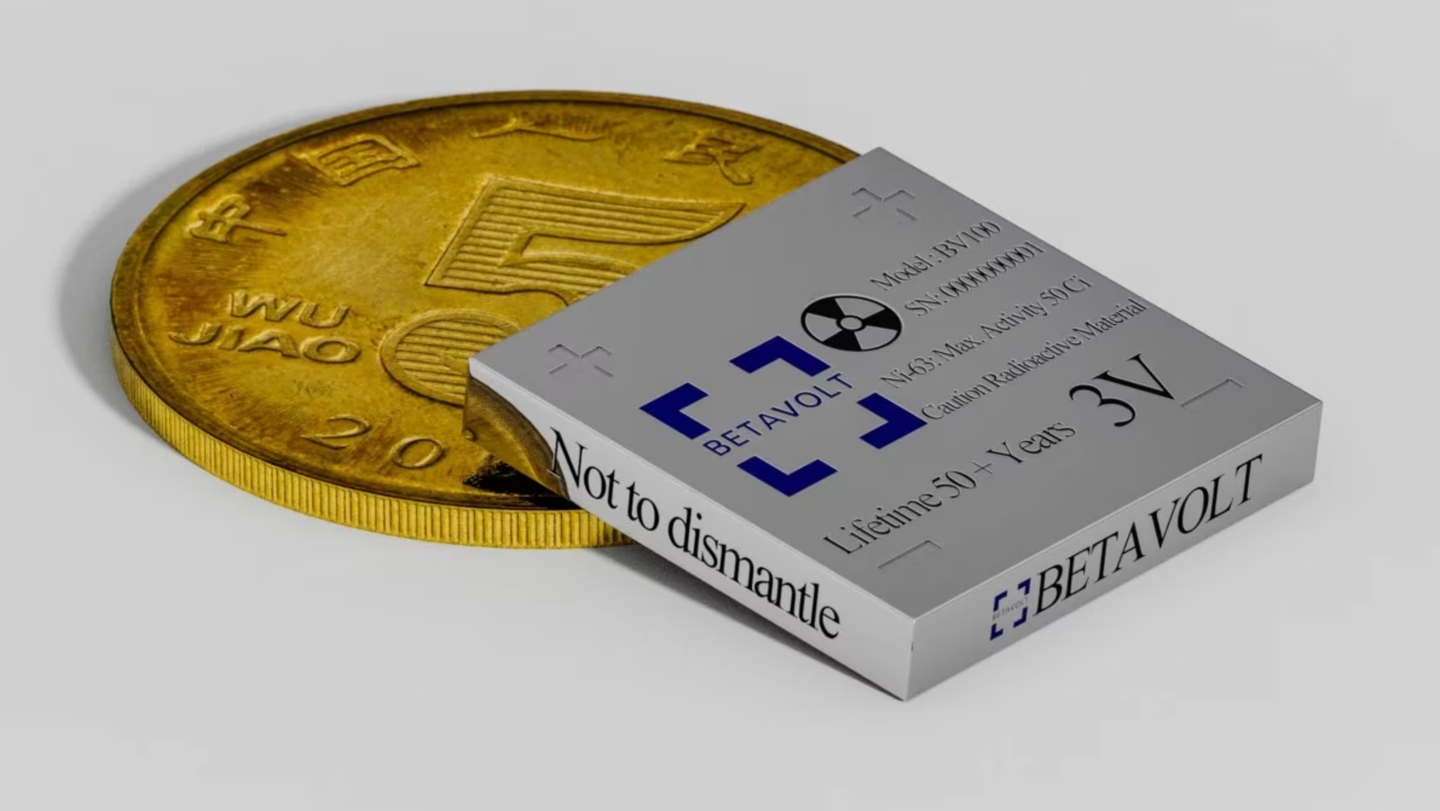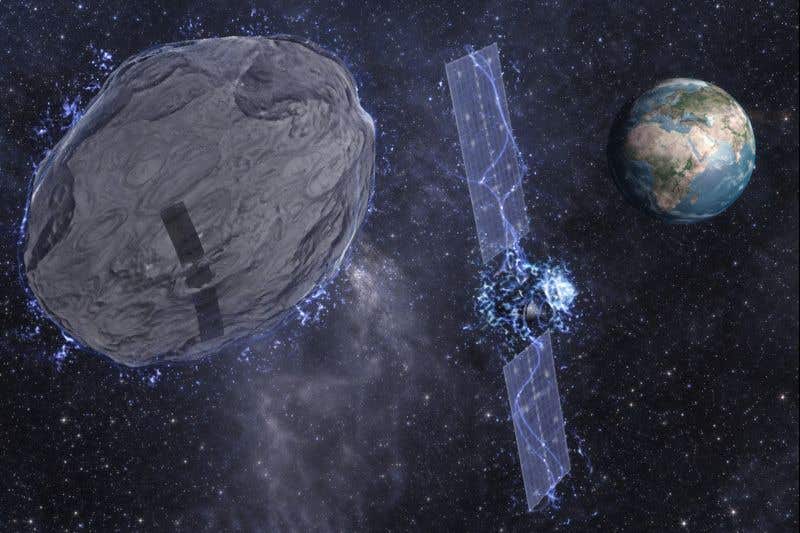Tiny nuclear battery produces 50 years of power on a single charge
A startup has unveiled a nuclear battery that could power devices for 50 years without needing a recharge.

A revolutionary advance in energy technology could transform how we power the future: a nuclear battery capable of supplying uninterrupted electricity for up to 50 years without ever needing to be recharged or maintained. (CREDIT: Betavolt Technologies)
A startup has unveiled a nuclear battery that could power devices for 50 years without needing a recharge. Developed by Betavolt, a firm based in Beijing, the new battery marks a bold leap forward in energy storage. It's designed to work continuously without maintenance, offering a game-changing option for powering small devices in the long term.
The heart of this technology lies in miniaturized atomic energy. Engineers have managed to embed the radioactive isotope Nickel-63 into a unit smaller than a coin. This tiny, self-sustaining module opens the door to entirely new ways of powering electronics, far beyond current lithium-ion limitations.
Betavolt’s design is now undergoing pilot testing and moving steadily toward mass production. Once commercialized, this nuclear battery could be used in everything from smartphones to surveillance drones. With no need for charging or servicing, it offers a new energy source where endurance matters most.
The battery’s layers, arranged with precision, form a highly efficient energy system. This architecture allows steady energy conversion over decades, making it ideal for next-gen tech. Betavolt’s team believes the design can be scaled and adapted across industries, offering lasting power where traditional batteries fall short.
Future applications include aerospace, wearable medical gear, artificial intelligence hardware, advanced microprocessors, sensors, and even micro-robots. In a statement, the company said its innovation could “support China’s lead in the ongoing AI revolution.” The battery’s energy comes from the steady decay of Nickel-63—a principle explored in labs since the 20th century.
Earlier nuclear batteries were developed during the Cold War by scientists in the U.S. and Soviet Union. These early versions powered space probes and remote outposts but were bulky and expensive. Betavolt’s compact and modern take on this old idea may finally unlock its potential for real-world consumer use.
Related Stories
China has now embarked on the ambitious endeavor to miniaturize and commercialize nuclear batteries as part of its 14th Five-Year Plan, aimed at strengthening the nation's economy from 2021 to 2025. Simultaneously, research institutions in the US and Europe are also actively engaged in the development of similar technologies.
Betavolt's inaugural nuclear battery boasts the capability to deliver 100 microwatts of power with a voltage of 3V while measuring a mere 15x15x5 cubic millimeters.
However, the company has ambitious plans to produce a battery with 1 watt of power by the year 2025. Their compact size opens the door to a myriad of possibilities, including mobile phones that never require charging and drones with perpetual flight capabilities.
Furthermore, the layered design of Betavolt's nuclear battery ensures safety. It is engineered to withstand sudden force without catching fire or exploding, providing added reassurance to potential users. The battery also demonstrates remarkable resilience, functioning efficiently in temperatures ranging from -60°C to 120°C.
Betavolt takes pride in highlighting the safety and environmental friendliness of its atomic energy batteries. The company emphasizes that these batteries have no external radiation and are well-suited for use in medical devices like pacemakers, artificial hearts, and cochlear implants within the human body.
Moreover, Betavolt underscores the environmental benefits of their technology. After the decay period, the isotope within the battery transform into a stable copper isotope, which is non-radioactive and poses no threat or pollution to the environment. This feature underscores the commitment to sustainability and eco-friendliness.
As China spearheads this transformative technology, the global community eagerly awaits the widespread commercial availability of Betavolt's atomic energy batteries, offering a promising glimpse into the future of sustainable and long-lasting power solutions.
The Previous Standard: NanoTritium batteries
Betavolt competes directly with City Labs' batteries from the United States which held the previous standard in nuclear micro batteries. City Labs' NanoTritium™ batteries are ultra-low-power, long-life betavoltaic devices that utilize the natural decay of tritium, a radioactive isotope of hydrogen, to generate continuous power for over 20 years. The first NanoTritium battery prototypes were developed in 2008 for encryption security memory backup power. They were released commercially in 2012 marking the first time tritium batteries could be purchased without requiring a radiation license.
Key Features:
- Longevity: Powered by tritium with a half-life of 12.32 years, these batteries provide consistent electrical power for more than two decades.
- Durability: Resistant to extreme temperatures ranging from -55°C to +150°C, as confirmed by independent testing conducted by Lockheed Martin.
- Safety: The tritium is incorporated in solid form within a hermetically sealed package, ensuring safe operation even in sensitive environments like medical implants.
- Regulatory Approval: City Labs has been granted a Product Regulatory General License to manufacture, sell, and distribute its NanoTritium™ batteries, making them the first betavoltaic power sources available to customers without requiring a radiation license.
City Labs Product Specifications:
- P100 Series: Offers an open circuit voltage of 0.8 to 2.4 volts and a short circuit current ranging from 50 to 350 nanoamps, suitable for nanowatt to microwatt power applications.
- P200 Series: Currently in development, this series aims to provide higher power outputs to accommodate a broader range of applications.
Betavoltaic Device Applications
Betavoltaic batteries are ideal for powering devices where battery replacement is difficult or impossible, such as:
- Environmental pressure and temperature sensors
- Intelligence sensors
- Medical implants
- Trickle charging lithium batteries
- Semi-passive and active RFIDs
- Silicon clocks
- SRAM memory backup
- Deep-sea oil well sensors
- Low-power processors (e.g., ASICs, FPGAs, microcontroller units)
These miniature nuclear batteries' long operational life and compact size make them valuable for specialized uses, despite their limited power output compared to traditional batteries.
Note: Materials provided above by The Brighter Side of News. Content may be edited for style and length.
Like these kind of feel good stories? Get The Brighter Side of News' newsletter.



